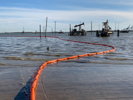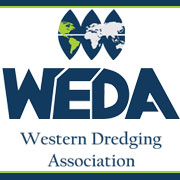Containment Boom - Oil Spill Boom Information
What is an Oil Containment Boom?
Oil slicks can cause damage to sensitive areas. Special equipment like oil booms can help minimize the harm caused to these areas. An oil boom (also known as a containment Boom) is a temporary floating barrier used to contain an accidental oil spillage. Oil booms can reduce the pollution of shorelines, rivers, oceans, and other waterways. They also collect oil in thicker surface layers, which allows for easy recovery for your business.
Texas Boom Company makes oil containment booms in its Houston, Texas facility. Our oil booms are made from industrial-strength materials that limit the spread and contain oil. We offer a complete line of oil spill containment booms that can be used in all situations, including air-inflated booms, self-inflating booms, and permanent booms. A containment boom's primary function is to limit the impact of chemical or hydrocarbon spillages. The performance of a floating boom is determined by its buoyancy, roll response, and heave response in a given application. This allows for the containment of hydrocarbons or chemicals during spill events. These factors can help you choose the best containment boom design. Oil booms reduce the environmental and financial impact of chemical or hydrocarbon spillages. They also limit the spread of the spillage to a limited area.
There are many types of containment booms, including permanent boom, permanent boom, and fence boom. A containment boom can be used to contain any hydrocarbon or chemical spillage provided it is applied according to federal, state, and local guidelines. There are several criteria that can be used to determine the best containment boom. These include water body classifications (ASTM F1523 and OPA 90), which are based on wave heights. These criteria determine the fundamental physical requirements, including the overall boom height and reserve buoyancy. Other considerations include the boom's roll in currents, heave reaction in waves, freeboard height, and skirt depth as well as forces on the boom. This will need to be reviewed in light of oil boom strength.
Oil booms need to be taken care of in accordance with the operations and maintenance manual. You should also consider the height of your boom stack; secure it on pallets to prevent abrasion; clean and repair any operational damage according to instructions. Boom accessories depend on the deployment requirements. These can include tow handles, handles, repair kits, anchor kits, rope, storage boxes, boom reels, deployment rollers, and pads.
It is important to evaluate the situation and use the appropriate criteria to select the right containment boom. This includes a review of the float/skirt heights as well as the reserve buoyancy, tensile strength, and reserve buoyancy. In most cases, proper boom containment should be achieved by following the correct deployment and containment guidelines.
If you require Containment Boom services, trust Texas Boom Company to assist you in removing oil spills.






